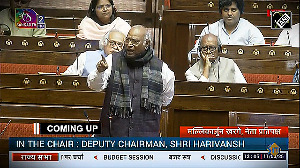If entertainment industry sources are to be believed, Playboy wants to launch an adult channel in India, and it is just one of more than 50 channels that telecasters want to launch in the next few months.
More than 23 free to air foreign channels and an estimated 20-25 more pay and niche channels could be on air in India in 2005.
To put that into perspective, India now has some 250 channels. Of these, 70-90 are available through the cable operator, without a set-top box. Some 130-140 are delivered either through a set-top box or via direct-to-home broadcasting.
Hordes of niche channels will be on air. After having tasted success with mass channels, major telecasters like Zee, Sahara and Star as well niche ones like MTV and UTV have drawn up plans to launch new channels.
The list of the new foreign channels that want to enter India is long. These include free to air international Urdu channels like Indus Vision, Geo Pak, ARY, ARY One, Indus Music, The Music, Uni Pus, KTN; English channels like Euro News, Now TV and Cine World (a pay channel), Arabic channels like Dubai TV, Dubai Sports, Al Jazeera and Saudi Channel 1, Spanish TVE International, Portugal's RTP International, Irania IRIB3, Japanese NHK Premium and Nepal's Nepal1.
At home, meanwhile, the Subroto Roy-controlled Sahara Samay has lined up six regional news channels catering to regional audiences in Rajasthan, Bihar, West Bengal, Tamil Nadu, Kerala and Andhra Pradesh.
Says Prabhat Dabral, vice-president, news and current affairs, Sahara Samay, "We have noticed that as in the case of the print media, the television audience is getting segmented. Regional aspirations are rising and so people are more keen to watch events happening closer home than international or even national affairs."
The group is launching vernacular language channels in Bengal and Rajasthan. The group's flagship channel, Sahara One, is planning a new Bollywood movie channel. Not to be outdone, Zee is planning on using its direct-to-home platform by launching cookery and travel channels.
MTV is planning to showcase Hollywood music on its new channel V1. Hindi news telecaster Aaj Tak is weighing the option of new channels trageting niche segments.
Star India is expected to announce its new niche channel plans once it gets the government's go-ahead on its DTH venture with the Tata group, according to a source at Star India.
"There is room for dedicated channels on classical music, gardening, motoring and travel on a DTH platform," the source says.
That's not all. Even small enterprises have channel plans. Kohinoor Broadcasting Corporation, the content company which reported over Rs 15 crore (Rs 150 million) of business in its first year of operation, has decided to set up its own telecasting facilities to air around eight channels at an investment of Rs 20 crore (Rs 200 million), according to a newspaper advertisement.
The Delhi-based Rai University along with other educational institutions is planning a 24-hour education channel, to be launched in two phases.
What explains this rush to launch new channels? Says Rajesh Jain, executive director at KPMG Consultants, "The domestic broadcasting industry is witnessing a fragmentation of viewership and the trend is expected to continue for the next 2-3 years. Hence regional players, niche players and new players will enter the television industry."
The fragmentation, according to Jain, is an outcome of India's cultural diversity, which has a bearing on the viewing habits of the masses.
Many national level broadcasters are thinking of moving into south India, which already accounts for more than 50 per cent of cable and satellite viewership.
"The industry will look at this market seriously and come out with customised content. The news industry which is already growing will see further impetus in the coming two years," forecasts Jain.
The television industry's revenues, according to a Federation of Indian Chambers and Commerce report on the entertainment industry, were Rs 12,900 crore (Rs 129 billion) in 2003, including revenue from advertising, subscription and software exports.
The industry, it is estimated, will grow by 20 per cent over the next five years to gross Rs 28,852 crore (Rs 288.52 billion) in revenue.
Yet can so many channels survive? Niche channels can, if they are on the direct-to-home distribution platform, because the DTH business is driven more by direct subscriptions than advertisements.
Says Meenakshi Madhvani, managing partner at media audit company Spatial Access Solutions, "While the general entertainment channels depended to a large extent on advertising revenues, for the niche channels 90 per cent of the revenue will be from subscriptions."
She does not rule out the possibility of targetted advertising arriving with niche channels. "At this juncture, DTH is the only addressable platform for the niche channel business model to be successful, though in the long run new modes of addressibility will come in India," agrees Sunil Khanna, who heads Zee's DTH business.
Television viewers will have more channels to surf through, but they'll also have to pay more for the privilege.
Says Ashok Mansukhani, executive vice president, corporate services, Hinduja TMT, "With niche channels, cable and satellite homes will see their monthly cable rents increasing by Rs 100 from the existing rate."






 © 2025
© 2025